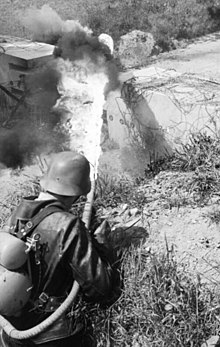Flammenwerfer 35
| Flammenwerfer 35 | |
|---|---|
| Type | Flamethrower |
| Place of origin | |
| Service history | |
| In service | 1935-1945 |
| Used by | German Army |
| Wars | Second World War |
| Production history | |
| Manufacturer | Different manufacturers |
| Produced | 1935-1941 |
| Specifications | |
| Mass | Template:Lb to kg |
| Crew | 1 |
| Effective firing range | 25 m |
| Maximum firing range | 30 m |
| Feed system | 1 (3 gal) gasoline compound (fuel) 1 Nitrogen tank (propellant) |
| Sights | None |
The Flammenwerfer 35, or FmW 35[citation needed] (literally, "flame thrower" or "thrower of flames") was the one-man German flamethrower used during World War II used to clear out trenches and buildings. This was a deadly weapon that was extremely effective at close range. This weapon was also known as the "skinsteal", because using this weapon at close range would usually result in severe skin loss, and the burning liquid compound used produced fumes very similar to Lachrymatory agents.
It had a weight of 35.8 kilograms (79 lb), and held 11.8 litres (2.6 imp gal; 3.1 US gal) of flaming oil, (Flammöl 19), gasoline mixed with tar to make it heavier and to give it better range, which was ignited by a hydrogen torch providing about 10 seconds of continuous use. The firing device is activated at the same time with the Selbstschlussventil and is to be found inside the protective pipe. The Flammenwerfer 35 was produced until 1941, when the lighter, slightly redesigned Flammenwerfer 41 began replacing it. During the later stages of its service life, the trigger and muzzle section of the Flammenwerfer were dressed up to look like a standard infantry rifle in an attempt to disguise operators and keep them from being singled out by enemy snipers.[citation needed]


External links
- http://www.waffenhq.de/infanterie/flammenwerfer41.html (German)
- http://www.firstworldwar.com/weaponry/flamethrowers.htm
